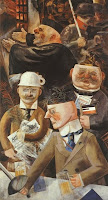 Today, we are going to do the same exercise as on Monday, just the other way round: you will be given the comments (in blue), and you have to compose the argument analysis that corresponds to those statements. Work in groups of 2-3. When you're done, email me your essay for participation points, and don't forget to put the names of all your group members on your essay.
Today, we are going to do the same exercise as on Monday, just the other way round: you will be given the comments (in blue), and you have to compose the argument analysis that corresponds to those statements. Work in groups of 2-3. When you're done, email me your essay for participation points, and don't forget to put the names of all your group members on your essay.You will describe the famous picture above. It is by Georg Grosz and is called "Pillars of Society" ("Stuetzen der Gesellschaft" in German).
In order to analyze this picture, you will need some background knowledge about it, as well as about the time it deals with, and the artist who created it, in order to understand what the artist "wanted to say with it."
Here are your cues:
A. Use meaningful transitions when you proceed from one paragraph to the next! Transitions could be: Thus, accordingly, contrarily, in the same vein, in opposition, another approach to ... could be, as Grosz himself stated, when compared with, etc.
B. INVENT A TITLE FOR YOUR ANALYSIS
C. Start with an ATTENTION CATCHER (one sentence that relates daily life to the topic of the picture).
1. Writer names the issue, relating the title of the picture to its main purpose. Writer redefines linguistic implication of who is ususually called a "pillar" of a society, and who it is in this case. Which society does Grosz mean?
YOUR TEXT
2. Writer describes the tone/feeling/attitude of the picture.
YOUR TEXT
3. Writer describes the picture in detail, discussing binaries of each figure depicted.
YOUR TEXT
4. Writer analyzes meaning of picture based on Grosz' background (his life, his aims, his state of mind, his feelings towards the society he lived in).
YOUR TEXT
5. Writer discusses meaning of picture with regard to Henrik Ibsen's play of the same name.
(Background knowledge about Ibsen's play.)
YOUR TEXT
6. Writer discusses effectiveness of this picture (personal opinion AND implication what it must have meant for Grosz to display that picture in the society he depicted).
YOUR TEXT
7. Writer discusses whether this picture can be called "ART." (Grosz was a Dadaist. Writer needs to explain what the Dada movement was before criticizing it.)
YOUR TEXT
8. Writer concludes with his/her personal opinion about Grosz' advice to artists what the purpose of their pictures should be.
YOUR TEXT

No comments:
Post a Comment